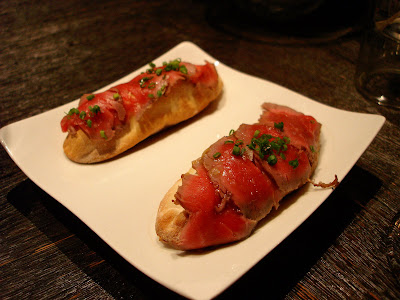
I'm being sent where? I know my work is relatively transient; I work a few weeks at a client before grabbing my laptop and heading out again. In fact, I don't even have a desk. When I go into the downtown office, I have to "hotel" a cubicle. But so far, my work has kept me around Los Angeles. Sometime in January, I was told that I was being sent to Arizona to help with an audit. Although I'm now stuck in Scottsdale for the workweek, I'm armed with a $59 per diem and free breakfast buffet. That's quite a bit of change to explore Scottsdale's dining scene.
More...
Of course, I'd be much more enthusiastic if Arizona actually had a dining scene. As a relatively newly populated area with little but white retirees, Scottsdale has a dearth of novel restaurants. Everywhere I turn, I'm confronted by imported Los Angeles and national chains. On my commute from the hotel to the client site, I pass a Flemmings, Houstons, Fogo de Chao, Mastro's, PF Chang's, McCormick's, and at least a dozen other casual-to-upscale restaurants you'd recognize. I've decided that due to the lack of diversity and youth, there's only a market for recognizable brands of the same boring food. Steak is the lay of the land, even in an area too dry to support cattle. Also, apparently old white people like sushi; though I still wouldn't trust raw fish so far inland.
That's why I decided to write a series on places actually worth trying out if you're ever on some corporate retreat out in the middle of the Sonoran Desert. Leave the chains; there's more to be tasted.
Hence, the first of my Scottsdale recommendations:
Stax Burger Bistro
4400 N Scottsdale Rd
Scottsdale, AZ 85251
(480) 946-4222
~$4 a slider
On recommendation from a coworker previously sent to this client, I went to Stax after work one night. Things were dying down by that time Thursday night. The location was in "Oldtown" Scottsdale, which only signifies that the buildings are five years older than the rest of town. Across the street from Saddlehouse Ranch, yes there's one here too, is a burger bar specializing in three-ounce sliders.
Though the server may tell you to order three sliders per person, I'd stick with two sliders and split a few sides. The sweet potato fries with various dipping sauces is a great choice. Each sauce is only $.25, so go crazy with the chipotle aioli, red pepper aioli, honey mustard aioli, jalapeno aioli, or just plain ketchup. The mac & cheese and buttered corn were mediocre. Actually, seeing "corn off the cob" on the menu made me think they just uncanned a Jolly Green Giant and melted a stick of butter into a bowl.
The restaurant really shines with its namesake sliders. Although I was bummed that they were out of the exotic sliders (made with boar, ostrich, venison, or whatever cheap wild meat they have that week), the three I chose were plenty satisfying. In the picture above, from foreground to back, I got an original beef slider with caramelized onions, mushrooms, and cheddar, a lamb slider with feta cheese, grape tomatoes and tabouli, and a kobe slider with asparagus. My verdict: order the first two, ditch the last. The kobe burger was a novelty at best; and from a taste test, did not have the marbling of real Wagyu. The lamb was my easily my favorite though. For the lamb lover, the intense flavor of the animal permeated my mouth with the first bite. Ground lamb is an unfortunate rarity in this country, so when you can find it, make sure to indulge.
At a burger bar like this, you can expect a fine selection of beers. With this kind of food, nothing pairs better. My local Tempe brewed Four Peaks Kilt Lifter Ale was no exception.
This is my second week in Scottsdale so far. Stax was one of the first restaurants to show me that there's might be something to eat in this town after all. But over the last few days, I've found a few more that I'd love to share. Support the independent restaurants!
^




















































